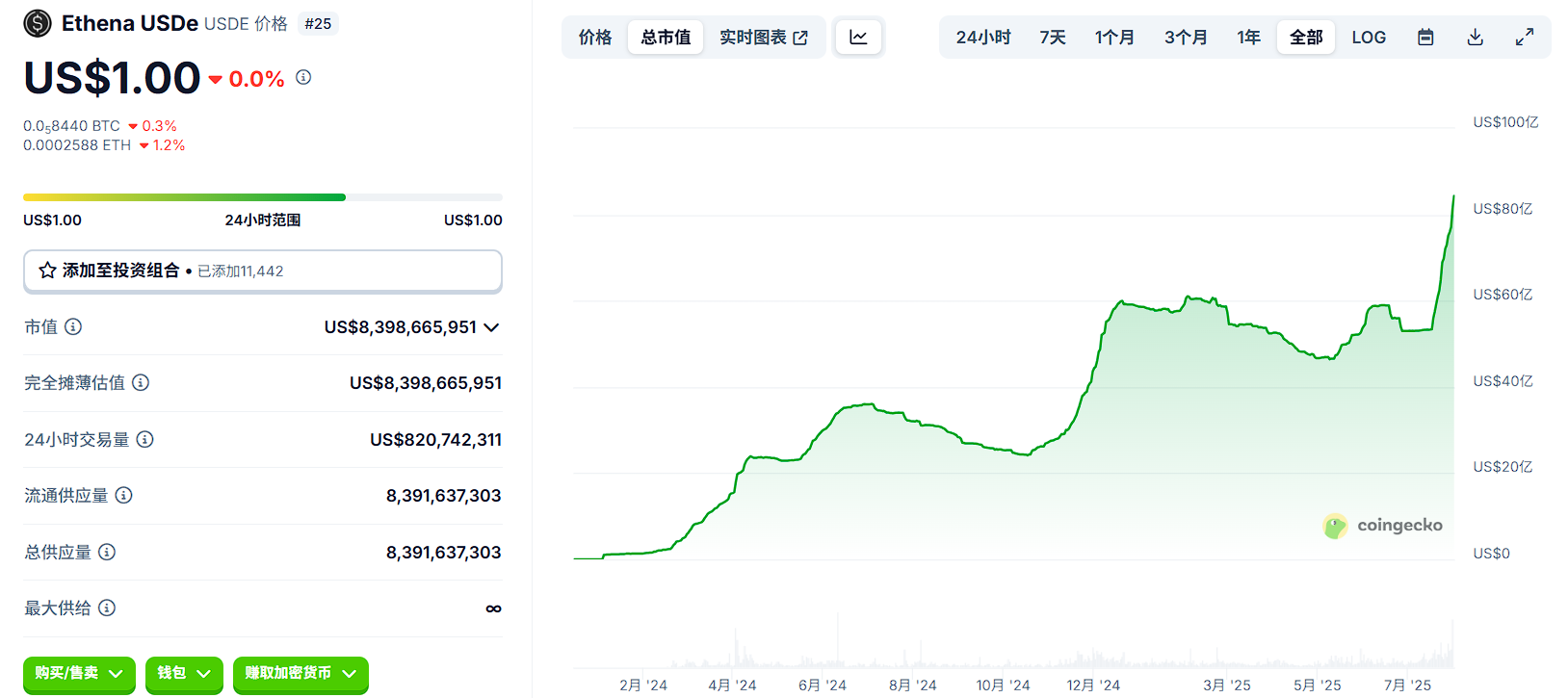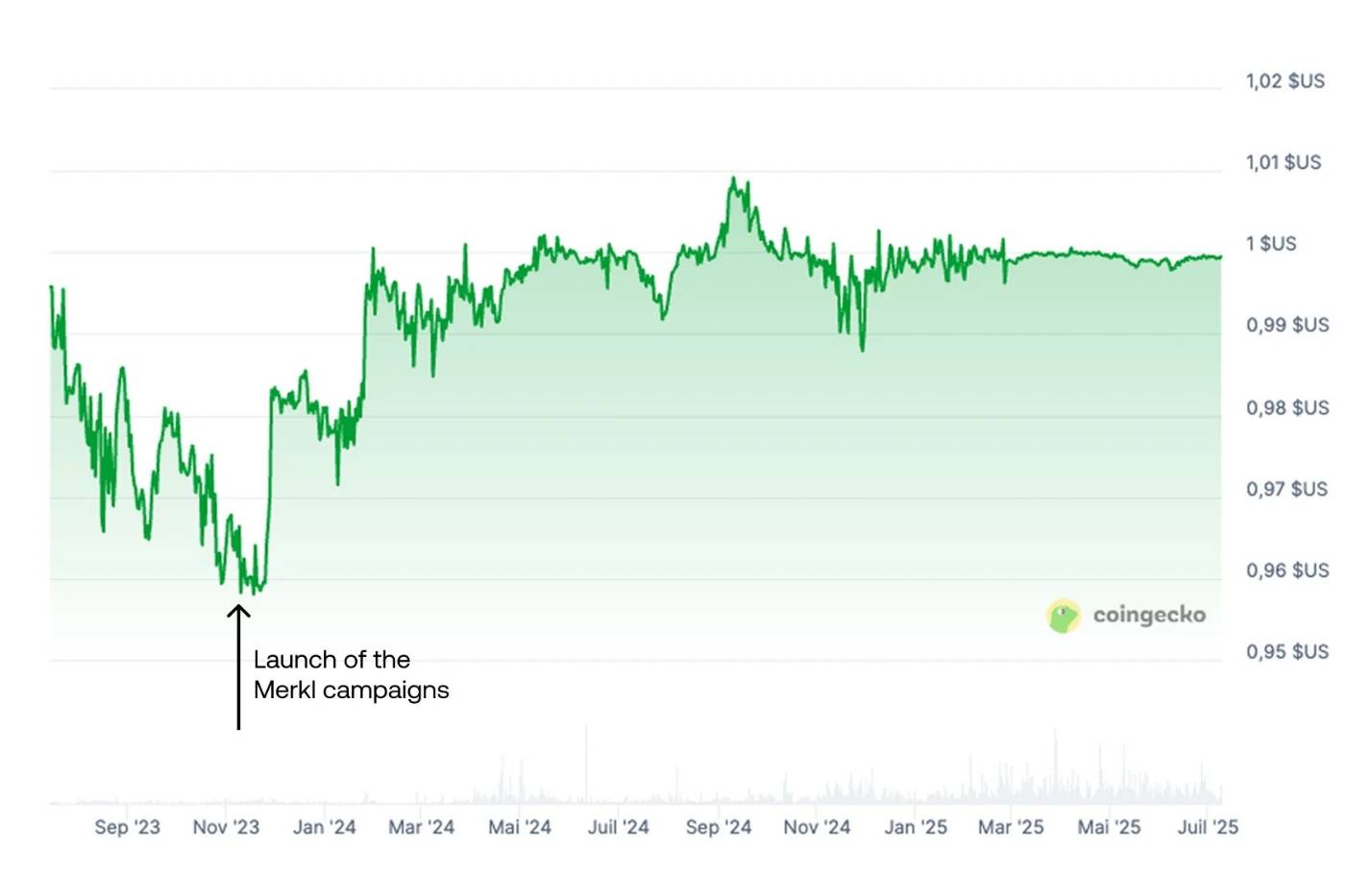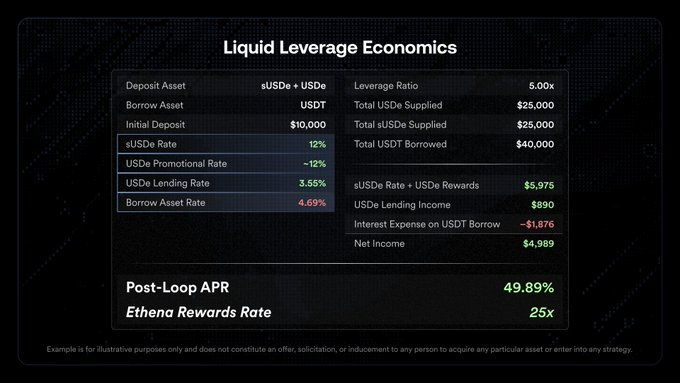Analyzing the systemic challenges hidden behind USDe/sUSDe and related platforms from the perspectives of revenue structure, user behavior, and capital flow.
Written by: Trendverse Lab
Since 2024, the stablecoin market has been undergoing a new change driven by structural innovation. After years of dominance by fiat-backed stablecoins like USDT and USDC, USDe, launched by Ethena Labs, has rapidly risen with its "no fiat support" synthetic stablecoin design, briefly surpassing a market cap of $8 billion, becoming the "high-yield dollar" in the DeFi world.
Recently, the Liquid Leverage staking activity jointly launched by Ethena and Aave has sparked market discussions: with an annualized return close to 50%, it appears to be a conventional incentive strategy, but it may also reveal another noteworthy signal—the structural liquidity pressure that the USDe model faces during the ETH bull market.
This article will focus on this incentive activity, briefly explain USDe/sUSDe and related platforms, and analyze the systemic challenges hidden behind it from the perspectives of revenue structure, user behavior, and capital flow, comparing it with historical cases like GHO to explore whether future mechanisms possess enough resilience to cope with extreme market scenarios.
1. Introduction to USDe and sUSDe: Synthetic Stablecoins Based on Native Crypto Mechanisms
USDe is a synthetic stablecoin launched by Ethena Labs in 2024, designed to avoid reliance on traditional banking systems and fiat issuance. As of now, its circulation has exceeded $8 billion. Unlike stablecoins like USDT or USDC, which are supported by fiat reserves, USDe's anchoring mechanism relies on on-chain crypto assets, particularly ETH and its derived staking assets (such as stETH, WBETH, etc.).

Image source: Coingecko
Its core mechanism is a "delta-neutral" structure: the protocol holds positions in assets like ETH while simultaneously opening equivalent perpetual short positions on centralized derivatives trading platforms. By hedging between spot and derivatives, USDe achieves a net asset exposure close to zero, stabilizing its price around $1.
sUSDe is the representative token obtained by users when they stake USDe in the protocol, featuring automatic yield accumulation. Its revenue sources mainly include: funding rate returns from ETH perpetual contracts and derivative yields from underlying staking assets. This model aims to introduce a continuous revenue model for stablecoins while maintaining their price anchoring mechanism.
2. Introduction to Aave and Merkl: A Collaborative System of Lending Protocols and Incentive Distribution Mechanisms
Aave is one of the oldest and most widely used decentralized lending protocols in the Ethereum ecosystem, dating back to 2017. Through its "flash loan" mechanism and flexible interest rate model, it early on promoted the popularity of DeFi lending systems. Users can deposit crypto assets into the Aave protocol to earn interest or borrow other tokens against collateral, all without intermediaries. Currently, the total value locked (TVL) in the Aave protocol is approximately $34 billion, with nearly 90% deployed on the Ethereum mainnet. The platform's native token AAVE has a total market cap of about $4.2 billion, ranking 31st on CoinMarketCap.

Data source: DeFiLlama
Merkl, on the other hand, is an on-chain incentive distribution platform launched by the Angle Protocol team, specifically designed to provide programmable and conditional incentive tools for DeFi protocols. By setting predefined parameters such as asset type, holding duration, and liquidity contribution, protocols can accurately define reward strategies and efficiently complete distribution processes. To date, Merkl has served over 150 projects and on-chain protocols, distributing a total of over $200 million in incentives, supporting multiple public chain networks including Ethereum, Arbitrum, and Optimism.
In the USDe incentive activity jointly initiated by Ethena and Aave, Aave is responsible for organizing the lending market, configuring parameters, and matching staking assets, while Merkl handles the reward logic setting and on-chain distribution operations.
In addition to the current USDe incentive collaboration, Aave and Merkl have previously formed stable cooperative relationships in multiple projects, with one of the most representative cases being their joint intervention in the GHO stablecoin's de-pegging issue.
GHO is a native over-collateralized stablecoin launched by Aave, which can be minted by collateralizing assets like ETH and AAVE. Initially, due to limited market acceptance and insufficient liquidity, the price of GHO quickly fell below its peg, hovering long-term in the $0.94 to $0.99 range, losing its price peg to the dollar.
To address this deviation, Aave and Merkl established a liquidity incentive mechanism for the GHO/USDC and GHO/USDT trading pairs on Uniswap V3. The incentive rules aimed to "target close to $1," providing higher rewards to liquidity providers who concentrated liquidity around $1, thereby guiding buy and sell depth to concentrate in the target range, forming a price stability wall on-chain. This mechanism proved effective in practice, successfully pushing the GHO price back up towards the $1 level.

This case reveals the essential role of Merkl in maintaining stability mechanisms: through programmable incentive strategies, it maintains the liquidity density of key trading ranges on-chain, akin to arranging "subsidized vendors" at market price anchors; only by continuously providing yields can a stable market structure be maintained. However, this also raises related issues: once incentives are interrupted or vendors withdraw, the support for the price mechanism may also fail.
3. Analysis of the Source Mechanism for 50% Annualized Returns
On July 29, 2025, Ethena Labs officially announced the launch of a feature module called "Liquid Leverage" on the Aave platform. This mechanism requires users to deposit sUSDe and USDe into the Aave protocol at a 1:1 ratio, forming a compound staking structure to obtain additional incentive returns.
Specifically, qualified users can obtain three sources of returns:
Incentive USDe rewards automatically distributed by Merkl (currently about 12% annualized);
The protocol revenue represented by sUSDe, which comes from the funding fees and staking yields of the delta-neutral strategy behind USDe;
The base deposit interest from Aave, which depends on the current market capital utilization rate and pool demand.
The specific participation process for this activity is as follows:
Users can obtain USDe through the Ethena official website (ethena.fi) or decentralized exchanges (such as Uniswap);
Stake the USDe held on the Ethena platform to exchange for sUSDe;
Transfer an equivalent amount of USDe and sUSDe into Aave at a 1:1 ratio;
Enable the "Use as Collateral" option on the Aave page;
Once the system detects compliant operations, the Merkl platform will automatically identify the address and regularly distribute rewards;

Image source: Official Twitter
Official data, underlying calculation logic breakdown:
Assuming: $10,000 principal, 5x leverage, total borrowing of $40,000, with $25,000 collateralized to USDe and sUSDe respectively.

Leverage Structure Explanation:
The premise of this yield relies on the compound structure established by the "borrowing - depositing - continuing to borrow" cycle, where the initial principal is used for the first round of staking, and after borrowing funds, it is used for the next round of dual deposits of USDe and sUSDe. By leveraging 5 times, the staking position is amplified, bringing the total investment to $50,000, thereby magnifying rewards and base yields.
4. Does the Incentive Plan Reveal That USDe and GHO Face the Same Structural Dilemmas?
Although both are stablecoins issued based on crypto asset staking, USDe and GHO have significant differences in their mechanisms. USDe maintains its peg through a delta-neutral structure, with historical prices generally stabilizing around $1 without experiencing the severe deviation of GHO de-pegging to $0.94, nor has it faced a liquidity crisis similar to relying on liquidity incentives to restore price. However, this does not mean USDe is completely immune to risks; its hedging model itself has potential vulnerabilities, especially during severe market fluctuations or when external incentives are withdrawn, it may face stability shocks similar to GHO.
Specific risks manifest in the following two aspects:
1. Negative funding rates, leading to declining or even inverted protocol revenues:
The main revenue of sUSDe comes from the LST yields obtained from staking assets like ETH, along with positive funding rates established on centralized derivatives platforms for ETH short perpetual contracts. Currently, with positive market sentiment, longs pay interest to shorts, maintaining positive returns. However, if the market turns weak, with an increase in shorts, funding rates may turn negative, requiring the protocol to pay additional fees to maintain hedging positions, thus reducing revenues, potentially even turning negative. Although Ethena has set up an insurance fund as a buffer, whether it can cover negative yields in the long term remains uncertain.
2. Termination of incentives → Promotional Rate 12% yield disappears directly
Currently, the Liquid Leverage activity being executed on the Aave platform only temporarily offers additional USDe rewards (approximately 12% annualized). Once the incentives end, the actual returns held by users will revert to the native yields of sUSDe (funding fees + LST yields) and the deposit interest rate on the Aave platform, which may collectively drop to the range of 15-20%. Furthermore, under a high leverage structure (such as 5x), the USDT borrowing rate (currently at 4.69%) will further compress the yield space. More seriously, in an extreme environment where funding is negative and interest rates are rising, users' net returns may be completely eroded or even turn negative.
If the incentives terminate, ETH declines, and funding rates turn negative simultaneously, the delta-neutral yield mechanism that the USDe model relies on will face substantial shocks, and sUSDe yields may drop to zero or even turn negative. If accompanied by large-scale redemptions and selling pressure, the price anchoring mechanism of USDe will also face challenges. This "multiple negative overlay" constitutes the most critical systemic risk in Ethena's current structure and may be the underlying reason for its recent high-intensity incentive activities.
5. Will Ethereum's Price Increase Stabilize the Structure?
Since the stability mechanism of USDe relies on the spot staking of Ethereum assets and derivatives hedging, its capital pool structure faces systemic withdrawal pressure during rapid increases in ETH prices. Specifically, when ETH prices approach market expectations, users often tend to redeem their staked assets early to realize profits or shift to other assets with higher returns. This behavior triggers a typical "ETH bull market → LST outflow → USDe contraction" chain reaction.

From DeFiLlama data, it can be observed that the TVL of USDe and sUSDe declined simultaneously during the ETH price surge in June 2025, and there was no increase in annualized yield (APY) accompanying the price rise. This phenomenon contrasts with the previous bull market (late 2024): at that time, after ETH reached its peak, the TVL gradually retreated, but the process was relatively slow, and users did not collectively redeem their staked assets early.
In the current cycle, the simultaneous decline of TVL and APY reflects an increasing concern among market participants regarding the sustainability of sUSDe yields. When price fluctuations and changes in funding costs bring potential negative yield risks to the delta-neutral model, user behavior exhibits higher sensitivity and responsiveness, with early exits becoming the mainstream choice. This phenomenon of capital withdrawal not only weakens USDe's expansion capability but also further amplifies its passive contraction characteristics during ETH's upward cycle.
Summary:
In summary, the current annualized yield of up to 50% is not the norm for the protocol but rather a result of multiple external incentives (Merkl airdrop + Aave collaboration) driving the phase. Once risks such as ETH price fluctuations, termination of incentives, and negative funding rates are concentrated, the delta-neutral yield structure that the USDe model relies on will face pressure, and sUSDe yields may quickly converge to 0 or turn negative, thereby impacting the stability anchoring mechanism.
Recent data shows that the TVL of USDe and sUSDe has declined during the ETH upward phase, and APY has not increased simultaneously. This "withdrawal during a rise" phenomenon indicates that market confidence is beginning to price in risks early. Similar to the "pegging crisis" faced by GHO, the current liquidity stability of USDe largely depends on continuous subsidies to maintain stability.
When this incentive game will end, and whether it can provide the protocol with enough structural resilience adjustment window, may become a key test of whether USDe truly possesses the potential of a "third pole of stablecoins."
免责声明:本文章仅代表作者个人观点,不代表本平台的立场和观点。本文章仅供信息分享,不构成对任何人的任何投资建议。用户与作者之间的任何争议,与本平台无关。如网页中刊载的文章或图片涉及侵权,请提供相关的权利证明和身份证明发送邮件到support@aicoin.com,本平台相关工作人员将会进行核查。




